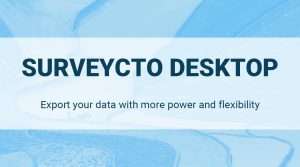Achieve data interoperability and streamline your fieldwork operations
In today’s data-driven world, error-free transfer of information between different systems is critical. This capability, known as data interoperability, is defined by the World Bank as the ability of different systems, databases, devices, or applications to communicate, execute programs, and transfer data with minimal user intervention. Interoperability ensures that data moves effortlessly between platforms, enabling comprehensive and cohesive analysis.
Why is this so important for international development organizations?
Not-for-profit and international non-governmental organizations increasingly rely on data to guide decision-making processes. This includes assessing community needs, evaluating program impacts, adjusting programming dynamically, using external tools for data monitoring and visualization, and making strategic resource allocation decisions. Data is also crucial for tracking progress, measuring outcomes, and communicating impact to stakeholders, ensuring transparency and accountability.
The increasing usage of data has also led to a higher demand for robust data workflows that optimize data collection, processing, visualization, and analysis. Moreover, advanced technologies such as artificial intelligence (AI) and machine learning are being employed for predictive analytics, trend analysis, and efficient data processing. Governments, nonprofits, and businesses alike can use these technologies to identify emerging needs and predict the potential impact of various initiatives.
Data interoperability has also become a foundational component in the quest for sustainable development and global progress. Achieving the United Nations’ 17 Sustainable Development Goals (SDGs) requires a collaborative approach where data from diverse sources must be integrated and made accessible to policymakers and governments. The SDG goals emphasize ending poverty, improving health and education, reducing inequality, spurring economic growth, tackling climate change, and preserving our oceans and forests. For such ambitious objectives, data must transfer smoothly across organizations and adhere to industry-specific standards, contributing to a broad, high-quality dataset that leaders can draw on to inform policy decisions and guide strategic actions.
As the demand for data interoperability grows, NGOs and nonprofits are increasingly expected to align their data systems with global standards. By preparing for interoperability now, NGOs and nonprofits can position their organizations for future success and collaboration.
For all these reasons, ensuring the interoperability of data is crucial for international development organizations. But how do organizations start becoming interoperability-ready?
Here are three steps your organization can take immediately to prepare your data for integration with other internal or external systems and better achieve data interoperability.

Step1: Assess where you’re at with data interoperability
The first step towards achieving data interoperability is to take stock of your current data integration capabilities. This involves conducting a foundational assessment to establish a clear understanding of your current data needs and capabilities.
To do this:
- Identify your data needs: Determine the data your organization requires, ensuring it aligns with your strategy and objectives.
- Assess current data collection practices: Verify that the data you collect supports your organizational goals and make full use of external data sources like satellite or sensor data. It is best practice to avoid collecting unnecessary data, and if your assessment determines that this is an issue, it is crucial to address this.
- Evaluate internal skills: Review the technical skills of your staff, including skills in data management, integration, database management, API development, data analysis, security, and metadata management. Then, select appropriate data collection, analysis, and management tools that align with these skills. Identify any need for additional training.
Once you have a solid understanding of your foundational data collection needs and practices, there are various frameworks you can apply to further assess your data interoperability status. Here are three that we recommend for developmental organizations.
This comprehensive guide provides a framework tailored for international development organizations to evaluate their data interoperability readiness. At a high level, this guide recommends:
- Conceptual frameworks to ensure data accessibility through standardized web interfaces and data metadata structures according to established models to promote a common understanding of data semantics.
- Standard classifications and vocabularies to ensure consistency in data interpretation and use.
- Open data formats and standard interfaces in non-proprietary formats like CSV, JSON, and XML for maximum interoperability and the use of application programming interfaces (APIs) to facilitate data access and integration.
- Legal and regulatory frameworks to establish laws and policies that govern data sharing and integration and ensure compliance with international, regional, and national legal standards to facilitate cross-jurisdictional data use.
2. HIMSS resources for global health
HIMSS measures interoperability in healthcare organizations through several parameters, including:
- Foundational interoperability: Involves the basic interconnectivity requirements for one system to communicate and exchange data with another securely.
- Structural interoperability: Focuses on the format, syntax, and organization of data exchanges, ensuring data integrity across systems.
- Semantic interoperability: Establishes common models and codification of data to ensure mutual intelligibility among users.
- Organizational interoperability: Includes governance, policy, and social, legal, and organizational considerations to facilitate secure and seamless data communication and usage.
2. World Bank interoperability frameworks
The World Bank believes data interoperability is essential for effective identity ecosystems, enabling various systems, databases, and devices to communicate and share data seamlessly. Interoperability frameworks, as laid out below, help to ensure efficient data exchange.
- Legal interoperability: Conduct “interoperability checks” by reviewing existing legislation to identify barriers like sectoral restrictions and vague data licenses, ensure coherence between organizations’ laws, and confirm digital applicability for processing identity data.
- Organizational interoperability: Align business processes, responsibilities, and expectations to achieve mutually beneficial goals and document them clearly.
- Semantic interoperability: Develop semantic vocabularies and schemata to ensure consistent understanding of data exchanges (e.g., using XML and JSON languages with metadata). Additionally, define the syntactic format of the information to be exchanged in terms of grammar and format.
- Technical interoperability: Adopt technical standards for system components and devices by using open specifications to ensure interoperability. Implement processes to select, evaluate, monitor, and test relevant standards and specifications, ensuring consistency across borders, and consult national and regional catalogs during ICT procurement and development.
Each layer relies on integrated public service governance to ensure usability, security, privacy, and performance. This means coordinating and documenting the organizational structures, roles, and responsibilities of stakeholders involved, setting requirements for quality and security, and implementing change management and business continuity plans to handle changes and ensure the continuous operation of digital public services, even in the event of cyberattacks or system failures.
Step 2: Carefully consider potential security issues
According to Data4SDGs’s guide to interoperability, not all datasets should be made interoperable. Identifying which data should be shared and which should be kept secure is a critical step. Here’s how to approach this:
1. Assessing data for interoperability
- Identify sensitive data: Determine which datasets contain sensitive information that should not be made interoperable. This includes personally identifiable information (PII), confidential business data, and any data that could pose a security risk if exposed.
- Classify data: Classify your data based on its sensitivity and the potential impact of its exposure. This helps in making informed decisions about what data can be shared and what should remain protected.
- Regulatory compliance: Ensure that data sharing practices comply with relevant regulations and standards, such as GDPR, HIPAA, and other data protection laws.
2. Determining which data is interoperable or not
According to Data4SDGs’s guide, certain types of data should be made interoperable while other data should never be made interoperable.
Data that should be made interoperable:
- Aggregated data that does not contain PII or sensitive information
- Publicly available data that can benefit from being shared across platforms
- Data that contributes to achieving global development goals and can be safely shared for broader analysis and decision-making
Data that should not be made interoperable:
- Raw data containing PII or sensitive business information
- Data that is subject to strict regulatory controls and privacy laws
- Information that could compromise individual privacy or organizational security if shared
In practical terms, this means that an organization might make data on overall vaccine rates in a given area interoperable, while removing the full names and addresses of the individuals who have received the vaccines from that interoperable dataset. This approach ensures that useful aggregate data is shared while protecting personal information and complying with privacy regulations.
3. Using best practices for secure data collection
To ensure the security of data collection processes, adopt the following best practices:
- Data security and privacy strategy: Align with program policies and standards, covering data classification, access, protection, and privacy.
- Data encryption: Use strong encryption methods to protect data during collection, transmission, and storage, ensuring intercepted data remains unreadable to unauthorized parties.
- Secure access controls: Implement role-based access controls to limit data access to authorized personnel only.
- Regular audits and monitoring: Conduct regular audits and monitor data collection processes for unusual activities to detect potential security breaches early.
- Data minimization: Collect only necessary data to reduce exposure risk.
- Anonymization and pseudonymization: Anonymize or pseudonymize data where possible to protect individual identities, making it difficult to trace data back to specific individuals if compromised.
- Training and awareness: Ensure staff involved in data collection are trained in data security best practices and understand the importance of protecting sensitive information.
- Data handling: Define data categorization criteria, methodologies for storage, retention, disposal, and archival.
- Data privacy: Establish accountability and design processes to address key privacy requirements.
- Personal data protection: Identify relevant regulations and develop policies for handling, protecting, and sharing personal data.
By carefully considering these potential security issues and adopting best practices for secure data collection, your organization can achieve data interoperability without compromising data security. This ensures that the benefits of data sharing are realized while maintaining the highest standards of data protection.
Step 3: Create a comprehensive data management strategy

Achieving data interoperability hinges on having a well-structured data management strategy. This strategy should encompass every aspect of data handling, from collection and monitoring to analysis, reporting, storage, and usage. Here’s an outline of a comprehensive strategy to guide your organization:
Structured data management strategy
1. Foundation
- Data strategy: Develop a clear and actionable data strategy that aligns with your organizational goals and objectives.
- Data management program and funding: Establish a robust data management program supported by adequate funding to ensure sustainability and scalability.
2. Execution
- Data architecture: Design a data architecture that supports interoperability and efficient data flow across systems.
- Tech architecture: Implement a technology architecture that integrates various tools and platforms, facilitating seamless data exchange.
- Data quality management: Ensure high standards of data quality through continuous monitoring and validation processes.
- Data governance: Establish data governance policies to manage data access, usage, and compliance with regulatory requirements.
3. Collaboration
- Data control environment: Create an environment that fosters collaboration and control over data usage, ensuring data integrity and security.
4. Application
- Analytics management: Implement robust analytics management practices to extract actionable insights from your data, driving informed decision-making.
Simplified strategy for smaller organizations
For smaller organizations, a simplified strategy may be more practical. Focus on key elements such as:
- Developing a basic data strategy that aligns with your core objectives
- Implementing essential data governance practices to maintain data quality and compliance
- Utilizing cost-effective tools and platforms that offer interoperability and integration capabilities
Leveraging interoperable tools
Once you’ve developed a comprehensive data management strategy, exploring specific tools to enhance your data interoperability is the next step. One such tool is the Application Programming Interface (API), which allows different software systems to communicate and exchange data seamlessly. APIs enable automated data transfers, real-time updates, synchronization with other databases, and integration with custom applications, providing a flexible solution for maintaining data interoperability.The SurveyCTO API, for instance, is designed to help facilitate seamless data exchange between systems. This API allows for the automated “pulling” of data from SurveyCTO into other platforms and databases. Whether it’s for real-time data updates, synchronization with other databases, or integration with custom applications, the API provides a flexible solution for maintaining data interoperability.
Maximize development outcomes with interoperability
Ultimately, interoperability increases the reach and impact of high-quality data. It enables decision-makers to make informed decisions, optimize resource allocation, and enhance the impact of programs and policies.
This means that data interoperability should become a critical component for international development organizations striving to achieve sustainable development goals. By ensuring that different systems, databases, and applications can seamlessly communicate and share data, your organization can harness the full potential of its data assets–both for your own goals, and in service of frameworks like the U.N.’s SDGs.
By following the steps outlined above and leveraging the right tools, your organization can begin the work of ensuring that their data systems are prepared for the future and ready to drive progress towards global development objectives.
To learn more about data integration and interoperability, check out these helpful resources:




